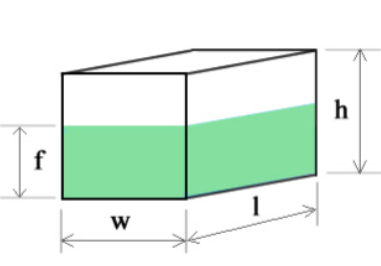Rectangle Tank Volume Calculator - Calculate volume in litres, gallons, cubic feet, bbl, cubic meters

Rectangle Tank Volume Formula
Where:
- l is the length of the tank
- w is the width of the tank
- h is the height of the tank
The formula is straightforward: to find the volume of a rectangular tank, simply multiply the three dimensions (length, width, and height). This applies to all types of rectangular containers, whether used for water storage, fish tanks, or industrial applications.
When the tank is partially filled, the volume of liquid inside the tank can be considered as a smaller rectangular prism. The new height of this smaller prism is the fill height, denoted as f, which is less than or equal to the total height h of the tank.
Where:
- l is the length of the tank
- w is the width of the tank
- f is the fill height of the tank (the height to which the tank is filled with liquid)
This formula is useful for determining the amount of liquid in a tank when it's partially filled. For instance, if you want to know how much water is in a tank that's filled halfway, you would use the fill height for f.
A1: If the tank is completely full, the fill height f is equal to the total height h of the tank. In this case, the filled volume is equal to the total volume of the tank.
A2: To calculate the volume of a tank, you must know all three dimensions: length, width, and height. If the length is unknown, it cannot be calculated solely based on the width and height. However, if the tank's shape allows for other measurements or references, those may help in determining the missing dimension.
A3: No, this formula is specifically for rectangular prism-shaped tanks. Irregularly shaped tanks (such as cylindrical or conical tanks) require different formulas that account for their unique geometry.
A4: If the fill height exceeds the total height of the tank, the tank would overflow. In such cases, the maximum fill height should be limited to the height of the tank, and any additional liquid would spill over the top.
 Home
Home Back
Back